Turbulent Heat Fluxes in a Mediterranean Eddy Quantified Using Seismic and Hydrographic Observations
Abstract
1. Introduction
2. Seismic and Hydrographic Data Acquisition
3. Methods
3.1. Seismic Processing
3.2. Temperature and Salinity Inversion
3.3. Turbulent Dissipation Rates Estimate
3.3.1. Horizontal Slope Spectra from Seismic Reflections
3.3.2. Strain and Shear Spectra from Hydrographic Data
3.3.3. Uncertainty Estimates
3.4. Turner Angle
3.5. Heat Fluxes
3.5.1. Diffusive Layers
3.5.2. Salt Fingers
3.5.3. Thermohaline Intrusions
4. Result
4.1. Dissipation Rates around the Meddy
4.1.1. Spatial Distribution of Dissipation Rates
4.1.2. Comparison of Dissipation Rates from the Seismic and Hydrographic Data
4.2. Observation of Mixing Processes around the Meddy and Associated Heat Fluxes
4.2.1. Diffusive Layers and Salt Fingers
4.2.2. Thermohaline Intrusions
4.3. Eddy Lifetime
5. Discussion
5.1. Turbulent Dissipation Rates and Heat Fluxes
5.2. The Feasibility of Seismic Oceanography on Investigating the Meddy Oceanography
6. Conclusions
Author Contributions
Funding
Institutional Review Board Statement
Informed Consent Statement
Data Availability Statement
Conflicts of Interest
Appendix A

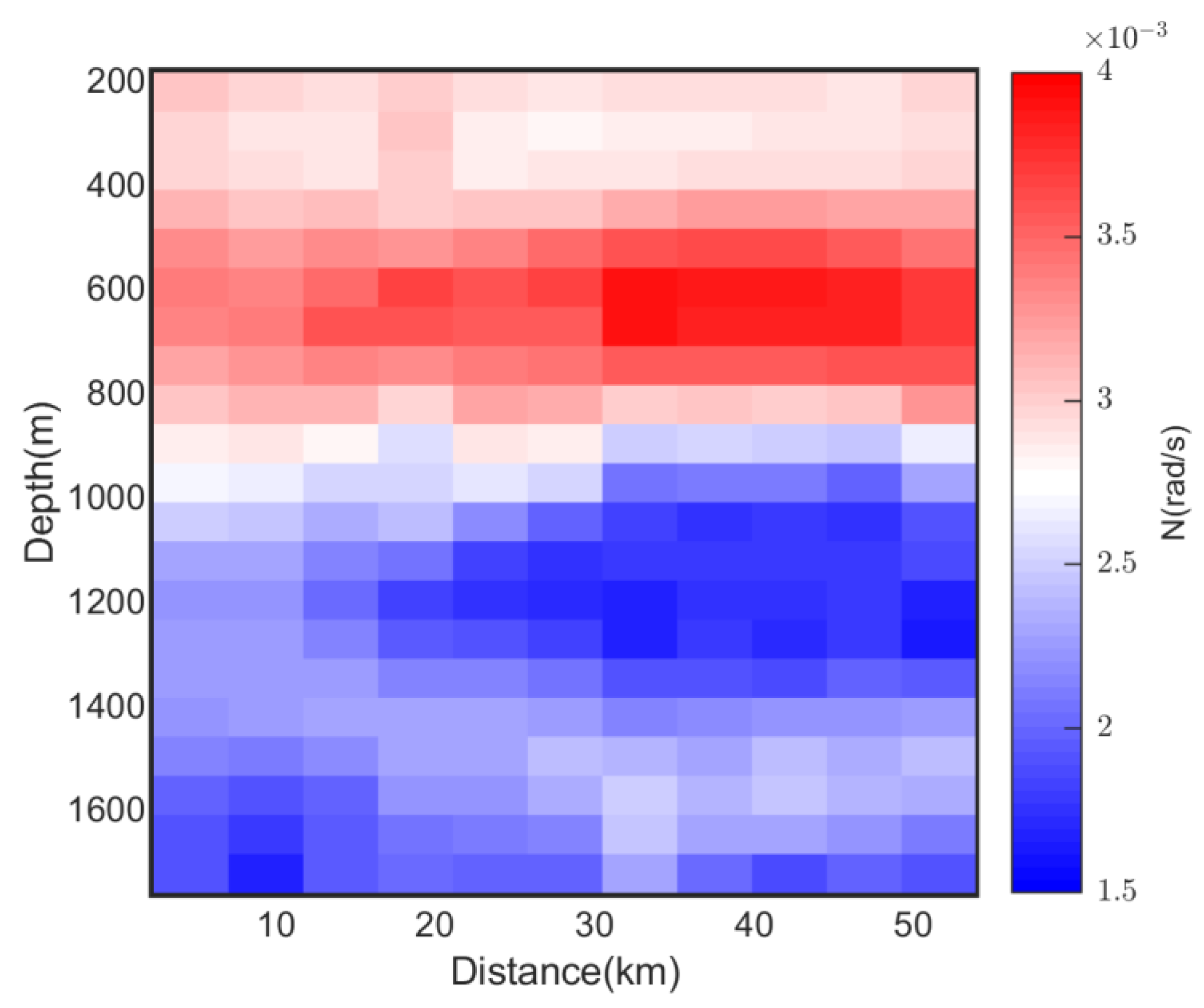
Appendix B. Uncertainty Analysis of Seismic and Hydrographic Derived Dissipation Rates
Appendix B.1. Unceratinties in Turbulent Disspation Rates frm Seismic Data
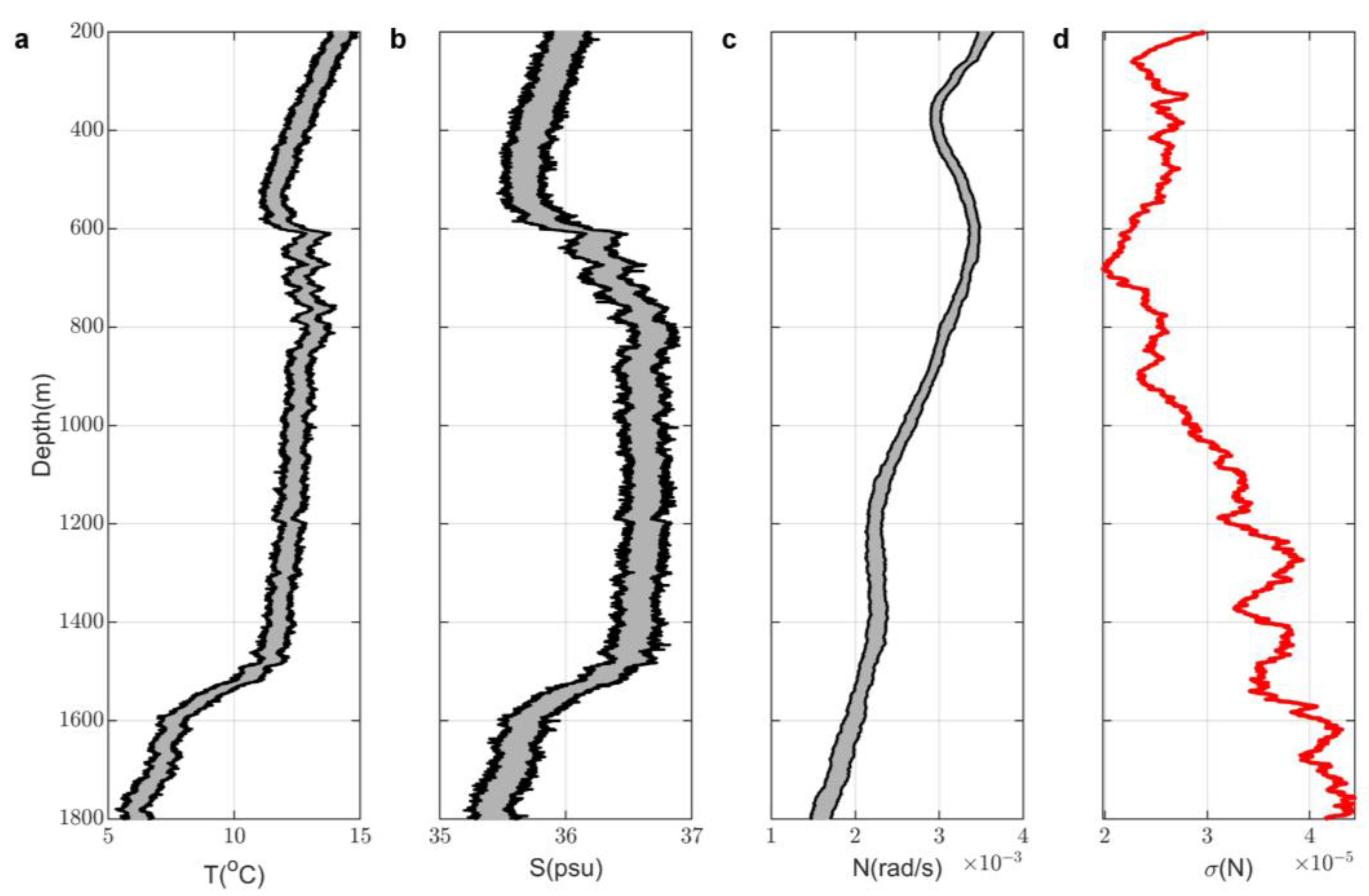

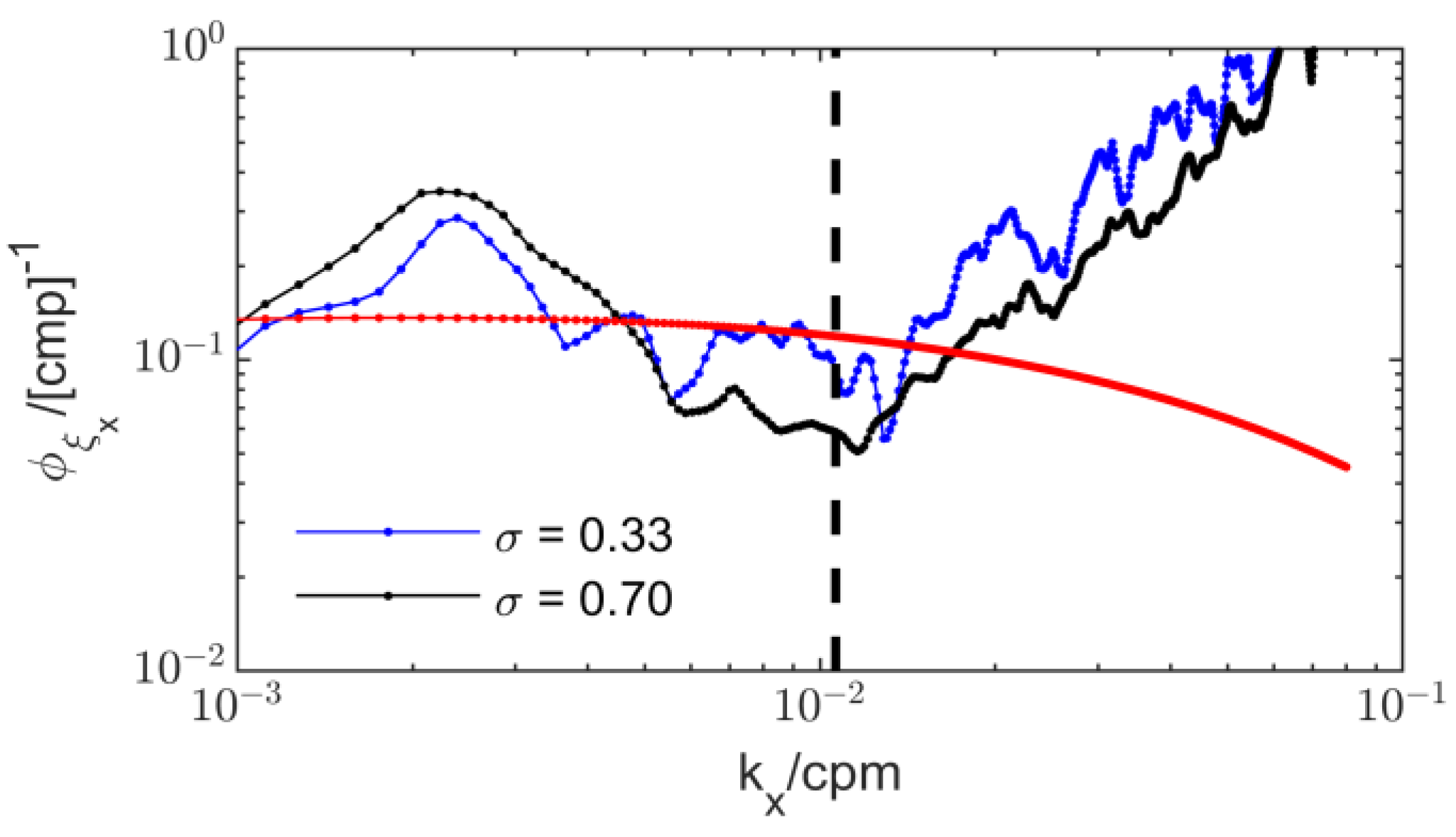
Appendix B.2. Unceratinties in Turbulent Disspation Rates from Hydrographic Data (CTD/LADCP)
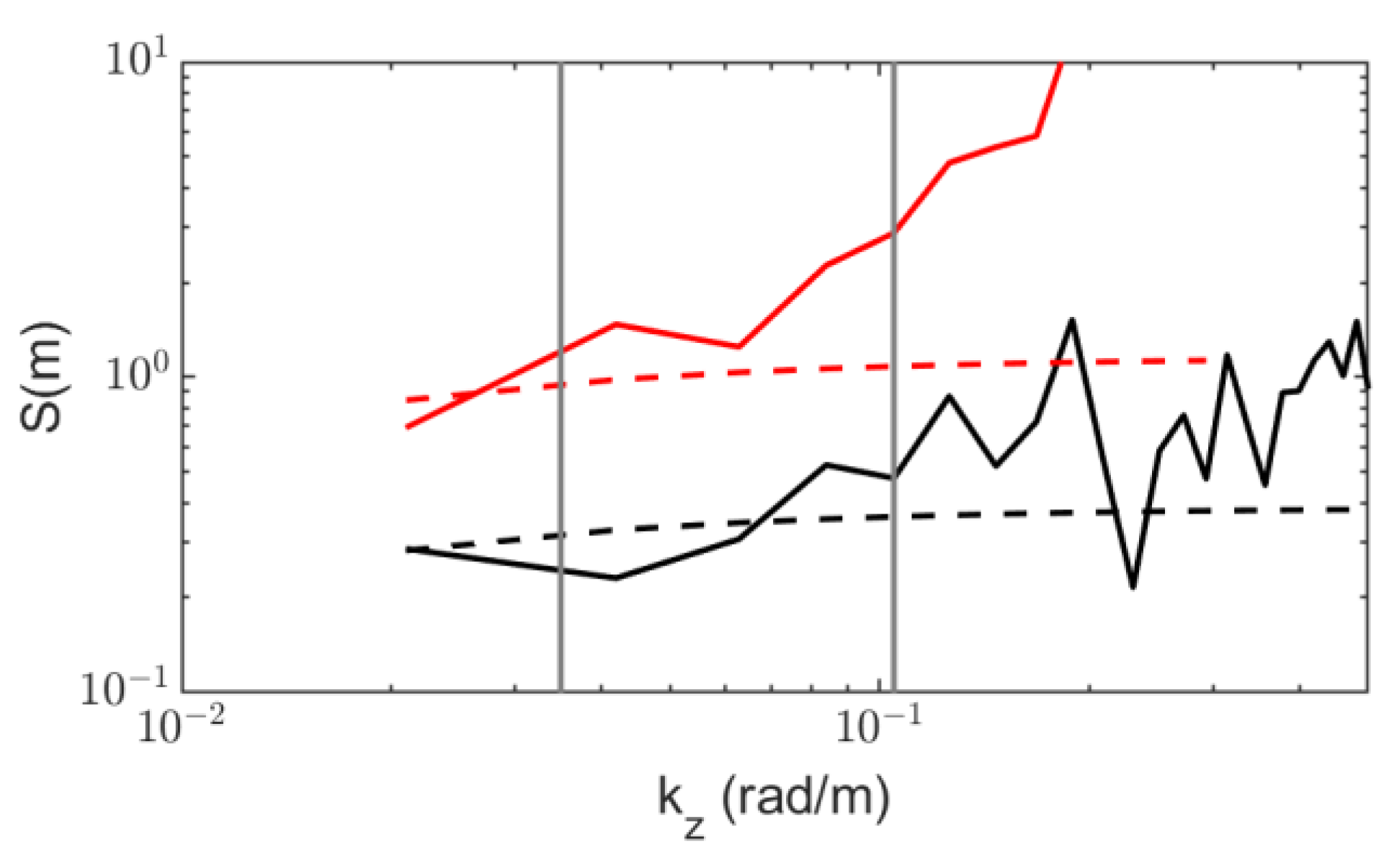
| N | Ea (No Unit) | Final Uncertainty (Logarithmic Units) | ||
|---|---|---|---|---|
| Seismic data | Neglectable | 1.43 | ||
| Hydrographic data | Neglectable | 1.43 |
References
- McWilliams, J.C. Submesoscale Currents in the Ocean. Proc. R. Soc. A Math. Phys. Eng. Sci. 2016, 472, 20160117. [Google Scholar] [CrossRef] [PubMed]
- D’Asaro, E.A. Generation of Submesoscale Vortices: A New Mechanism. J. Geophys. Res. 1988, 93, 6685. [Google Scholar] [CrossRef]
- Molemaker, M.J.; McWilliams, J.C.; Dewar, W.K. Submesoscale Instability and Generation of Mesoscale Anticyclones near a Separation of the California Undercurrent. J. Phys. Oceanogr. 2015, 45, 613–629. [Google Scholar] [CrossRef]
- Thomsen, S.; Kanzow, T.; Krahmann, G.; Greatbatch, R.J.; Dengler, M.; Lavik, G. The Formation of a Subsurface Anticyclonic Eddy in the Peru-Chile Undercurrent and Its Impact on the near-Coastal Salinity, Oxygen, and Nutrient Distributions. J. Geophys. Res. Ocean. 2016, 121, 476–501. [Google Scholar] [CrossRef]
- McCoy, D.; Bianchi, D.; Stewart, A.L. Global Observations of Submesoscale Coherent Vortices in the Ocean. Prog. Oceanogr. 2020, 189, 102452. [Google Scholar] [CrossRef]
- Frenger, I.; Bianchi, D.; Stührenberg, C.; Oschlies, A.; Dunne, J.; Deutsch, C.; Galbraith, E.; Schütte, F. Biogeochemical Role of Subsurface Coherent Eddies in the Ocean: Tracer Cannonballs, Hypoxic Storms, and Microbial Stewpots? Glob. Biogeochem. Cycles 2018, 32, 226–249. [Google Scholar] [CrossRef]
- Sheen, K.L.; Brearley, J.A.; Naveira Garabato, A.C.; Smeed, D.A.; Laurent, L.S.; Meredith, M.P.; Thurnherr, A.M.; Waterman, S.N. Modification of Turbulent Dissipation Rates by a Deep Southern Ocean Eddy. Geophys. Res. Lett. 2015, 42, 3450–3457. [Google Scholar] [CrossRef]
- Fine, E.C.; MacKinnon, J.A.; Alford, M.H.; Mickett, J.B. Microstructure Observations of Turbulent Heat Fluxes in a Warm-Core Canada Basin Eddy. J. Phys. Oceanogr. 2018, 48, 2397–2418. [Google Scholar] [CrossRef]
- Bower, A.S.; Armi, L.; Ambar, I. Lagrangian Observations of Meddy Formation during a Mediterranean Undercurrent Seeding Experiment. J. Phys. Oceanogr. 1997, 27, 2545–2575. [Google Scholar] [CrossRef]
- Richardson, P.L.; Bower, A.S.; Zenk, W. A Census of Meddies Tracked by Floats. Prog. Oceanogr. 2000, 45, 209–250. [Google Scholar] [CrossRef]
- Candela, J. Chapter 5.7 Mediterranean Water and Global Circulation. In International Geophysics; Elsevier: Amsterdam, The Netherlands, 2001; p. 419-XLVIII. [Google Scholar]
- Reid, J.L. On the Total Geostrophic Circulation of the North Atlantic Ocean: Flow Patterns, Tracers, and Transports. Prog. Oceanogr. 1994, 33, 1–92. [Google Scholar] [CrossRef]
- Armi, L.; Hebert, D.; Oakey, N.; Price, J.F.; Richardson, P.L.; Rossby, H.T.; Ruddick, B. Two Years in the Life of a Mediterranean Salt Lens. J. Phys. Oceanogr. 1989, 19, 354–370. [Google Scholar] [CrossRef]
- Ruddick, B. Intrusive Mixing in a Mediterranean Salt Lens—Intrusion Slopes and Dynamical Mechanisms. J. Phys. Oceanogr. 1992, 22, 1274–1285. [Google Scholar] [CrossRef]
- Ruddick, B.; Hebert, D. The Mixing of Meddy “Sharon”; Elsevier: Amsterdam, The Netherlands, 1988; pp. 249–261. [Google Scholar]
- Hebert, D. Estimates of Salt-Finger Fluxes. Deep Sea Res. Part A Oceanogr. Res. Pap. 1988, 35, 1887–1901. [Google Scholar] [CrossRef]
- Hebert, D.; Oakey, N.; Ruddick, B. Evolution of a Mediterranean Salt Lens: Scalar Properties. J. Phys. Oceanogr. 1990, 20, 1468–1483. [Google Scholar] [CrossRef][Green Version]
- Ruddick, B.R.; Oakey, N.S.; Hebert, D. Measuring Lateral Heat Flux across a Thermohaline Front: A Model and Observational Test. J. Mar. Res. 2010, 68, 523–539. [Google Scholar] [CrossRef]
- Stern, M.E. Lateral Mixing of Water Masses. Deep Sea Res. Oceanogr. Abstr. 1967, 14, 747–753. [Google Scholar] [CrossRef]
- Ruddick, B.R.; Turner, J.S. The Vertical Length Scale of Double-Diffusive Intrusions. Deep Sea Res. Part A Oceanogr. Res. Pap. 1979, 26, 903–913. [Google Scholar] [CrossRef]
- Ruddick, B.; Richards, K. Oceanic Thermohaline Intrusions: Observations. Prog. Oceanogr. 2003, 56, 499–527. [Google Scholar] [CrossRef]
- Holbrook, W.S.; Páramo, P.; Pearse, S.; Schmitt, R.W. Thermohaline Fine Structure in an Oceanographic Front from Seismic Reflection Profiling. Science 2003, 301, 821–824. [Google Scholar] [CrossRef]
- Ruddick, B.; Song, H.; Dong, C.; Pinheiro, L. Water Column Seismic Images as Maps of Temperature Gradient. Oceanography 2009, 22, 192–205. [Google Scholar] [CrossRef]
- Sallarès, V.; Biescas, B.; Buffett, G.; Carbonell, R.; Dañobeitia, J.J.; Pelegrí, J.L. Relative Contribution of Temperature and Salinity to Ocean Acoustic Reflectivity. Geophys. Res. Lett. 2009, 36, L00D06. [Google Scholar] [CrossRef]
- Biescas, B.; Sallarès, V.; Pelegrí, J.L.; Machín, F.; Carbonell, R.; Buffett, G.; Dañobeitia, J.J.; Calahorrano, A. Imaging Meddy Finestructure Using Multichannel Seismic Reflection Data. Geophys. Res. Lett. 2008, 35, 1–5. [Google Scholar] [CrossRef]
- Pinheiro, L.M.; Song, H.; Ruddick, B.; Dubert, J.; Ambar, I.; Mustafa, K.; Bezerra, R. Detailed 2-D Imaging of the Mediterranean Outflow and Meddies off W Iberia from Multichannel Seismic Data. J. Mar. Syst. 2010, 79, 89–100. [Google Scholar] [CrossRef]
- Ménesguen, C.; Hua, B.L.; Carton, X.; Klingelhoefer, F.; Schnürle, P.; Reichert, C. Arms Winding around a Meddy Seen in Seismic Reflection Data Close to the Morocco Coastline. Geophys. Res. Lett. 2012, 39, 1–6. [Google Scholar] [CrossRef]
- Gunn, K.L.; Dickinson, A.; White, N.J.; Caulfield, C.; Cille, P. Vertical Mixing and Heat Fluxes Conditioned by a Seismically Imaged Oceanic Front. Front. Mar. Sci. 2021, 8, 1–17. [Google Scholar] [CrossRef]
- Sheen, K.L.; White, N.J.; Hobbs, R.W. Estimating Mixing Rates from Seismic Images of Oceanic Structure. Geophys. Res. Lett. 2009, 36, L00D04. [Google Scholar] [CrossRef]
- Dickinson, A.; White, N.J.; Caulfield, C.P. Spatial Variation of Diapycnal Diffusivity Estimated From Seismic Imaging of Internal Wave Field, Gulf of Mexico. J. Geophys. Res. Ocean. 2017, 122, 9827–9854. [Google Scholar] [CrossRef]
- Falder, M.; White, N.J.; Caulfield, C.P. Seismic Imaging of Rapid Onset of Stratified Turbulence in the South Atlantic Ocean. J. Phys. Oceanogr. 2016, 46, 1023–1044. [Google Scholar] [CrossRef]
- Tang, Q.; Jing, Z.; Lin, J.; Sun, J. Diapycnal Mixing in the Subthermocline of the Mariana Ridge from High-Resolution Seismic Images. J. Phys. Oceanogr. 2021, 51, 1283–1300. [Google Scholar] [CrossRef]
- Holbrook, W.S.; Fer, I.; Schmitt, R.W.; Lizarralde, D.; Klymak, J.M.; Helfrich, L.C.; Kubichek, R. Estimating Oceanic Turbulence Dissipation from Seismic Images. J. Atmos. Ocean. Technol. 2013, 30, 1767–1788. [Google Scholar] [CrossRef]
- Holbrook, W.S.; Fer, I. Ocean Internal Wave Spectra Inferred from Seismic Reflection Transects. Geophys. Res. Lett. 2005, 32, 2–5. [Google Scholar] [CrossRef]
- Papenberg, C.; Klaeschen, D.; Krahmann, G.; Hobbs, R.W. Ocean Temperature and Salinity Inverted from Combined Hydrographic and Seismic Data. Geophys. Res. Lett. 2010, 37, 6–11. [Google Scholar] [CrossRef]
- Biescas, B.; Ruddick, B.R.; Nedimovic, M.R.; Sallarès, V.; Bornstein, G.; Mojica, J.F. Recovery of Temperature, Salinity, and Potential Density from Ocean Reflectivity. J. Geophys. Res. Ocean. 2014, 119, 3171–3184. [Google Scholar] [CrossRef]
- Xiao, W.; Sheen, K.L.; Tang, Q.; Shutler, J.; Hobbs, R.; Ehmen, T. Temperature and Salinity Inverted for a Mediterranean Eddy Captured With Seismic Data, Using a Spatially Iterative Markov Chain Monte Carlo Approach. Front. Mar. Sci. 2021, 8, 734125. [Google Scholar] [CrossRef]
- Song, H.; Pinheiro, L.M.; Ruddick, B.; Teixeira, F.C. Meddy, Spiral Arms, and Mixing Mechanisms Viewed by Seismic Imaging in the Tagus Abyssal Plain (SW Iberia). J. Mar. Res. 2011, 2, 827–842. [Google Scholar] [CrossRef]
- Biescas, B.; Armi, L.; Sallarès, V.; Gràcia, E. Seismic Imaging of Staircase Layers below the Mediterranean Undercurrent. Deep Res. Part I Oceanogr. Res. Pap. 2010, 57, 1345–1353. [Google Scholar] [CrossRef]
- Bai, Y.; Song, H.B.; Dong, C.Z.; Liu, B.R.; Chen, J.X.; Geng, M.H. Extraction of Mixing Parameters by Seismic Oceanography and Applications: Case Study of the Internal Waves in South China Sea and Mediterranean Eddy. Acta Geophys. Sin. 2015, 58, 2473–2485. [Google Scholar] [CrossRef]
- McPhee, M.G.; Kottmeier, C.; Morison, J.H. Ocean Heat Flux in the Central Weddell Sea during Winter. J. Phys. Oceanogr. 1999, 29, 1166–1179. [Google Scholar] [CrossRef]
- Padman, L.; Dillon, T.M. Vertical Heat Fluxes through the Beaufort Sea Thermohaline Staircase. J. Geophys. Res. 1987, 92, 10799. [Google Scholar] [CrossRef]
- Meyer, A.; Fer, I.; Sundfjord, A.; Peterson, A.K. Mixing Rates and Vertical Heat Fluxes North of Svalbard from Arctic Winter to Spring. J. Geophys. Res. Ocean. 2017, 122, 4569–4586. [Google Scholar] [CrossRef]
- Hobbs, R.W. RRS Discovery D318a & D318b Cruise Report. Available online: https://www.bodc.ac.uk/resources/inventories/cruise_inventory/reports/d318.pdf (accessed on 22 May 2022).
- Tang, Q.; Hobbs, R.; Zheng, C.; Biescas, B.; Caiado, C. Markov Chain Monte Carlo Inversion of Temperature and Salinity Structure of an Internal Solitary Wave Packet from Marine Seismic Data. J. Geophys. Res. Ocean. 2016, 121, 3692–3709. [Google Scholar] [CrossRef]
- Ballabrera-Poy, J.; Mourre, B.; Garcia-Ladona, E.; Turiel, A.; Font, J. Linear and Non-Linear T–S Models for the Eastern North Atlantic from Argo Data: Role of Surface Salinity Observations. Deep Sea Res. Part I Oceanogr. Res. Pap. 2009, 56, 1605–1614. [Google Scholar] [CrossRef]
- Krahmann, G.; Papenberg, C.; Brandt, P.; Vogt, M. Evaluation of Seismic Reflector Slopes with a Yoyo-CTD. Geophys. Res. Lett. 2009, 36, 1–5. [Google Scholar] [CrossRef]
- Sheen, K.L.; White, N.; Caulfield, C.P.; Hobbs, R.W. Estimating Geostrophic Shear from Seismic Images of Oceanic Structure. J. Atmos. Ocean. Technol. 2011, 28, 1149–1154. [Google Scholar] [CrossRef]
- Barnes, A.E. A Tutorial on Complex Seismic Trace Analysis. Geophysics 2007, 72, W33–W43. [Google Scholar] [CrossRef]
- Thomson, D.J. Spectrum Estimation and Harmonic Analysis. Proc. IEEE 1982, 70, 1055–1096. [Google Scholar] [CrossRef]
- Garrett, C.; Munk, W. Space-Time Scales of Internal Waves: A Progress Report. J. Geophys. Res. 1975, 80, 291–297. [Google Scholar] [CrossRef]
- Cairns, J.L.; Williams, G.O. Internal Wave Observations from a Midwater Float, 2. J. Geophys. Res. 1976, 81, 1943–1950. [Google Scholar] [CrossRef]
- Gargett, A.E.; Hendricks, P.J.; Sanford, T.B.; Osborn, T.R.; Williams, A.J. A Composite Spectrum of Vertical Shear in the Upper Ocean. J. Phys. Oceanogr. 1981, 11, 1258–1271. [Google Scholar] [CrossRef]
- Batchelor, G.K.; Howells, I.D.; Townsend, A.A. Small-Scale Variation of Convected Quantities like Temperature in Turbulent Fluid Part 2. The Case of Large Conductivity. J. Fluid Mech. 1959, 5, 134. [Google Scholar] [CrossRef]
- Jun, H.; Jou, H.; Kim, C.; Lee, S.H.; Kim, H. Random Noise Attenuation of Sparker Seismic Oceanography Data with Machine Learning. Ocean. Sci. 2020, 16, 1367–1383. [Google Scholar] [CrossRef]
- Polzin, K.L.; Toole, J.M.; Schmitt, R.W. Finescale Parameterizations of Turbulent Dissipation. J. Phys. Oceanogr. 1995, 25, 306–328. [Google Scholar] [CrossRef]
- Gregg, M.C.; Sanford, T.B.; Winkel, D.P. Reduced Mixing from the Breaking of Internal Waves in Equatorial Waters. Nature 2003, 422, 513. [Google Scholar] [CrossRef]
- Waterman, S.; Naveira Garabato, A.C.; Polzin, K.L. Internal Waves and Turbulence in the Antarctic Circumpolar Current. J. Phys. Oceanogr. 2013, 43, 259–282. [Google Scholar] [CrossRef]
- Bray, N.A.; Fofonoff, N.P. Available Potential Energy for MODE Eddies. J. Phys. Oceanogr. 1981, 11, 30–47. [Google Scholar] [CrossRef]
- Kunze, E.; Firing, E.; Hummon, J.M.; Chereskin, T.K.; Thurnherr, A.M. Global Abyssal Mixing Inferred from Lowered ADCP Shear and CTD Strain Profiles. J. Phys. Oceanogr. 2006, 36, 1553–1576. [Google Scholar] [CrossRef]
- Sheen, K.L.; Brearley, J.A.; Garabato, A.C.N.; Smeed, D.A.; Waterman, S.; Ledwell, J.R.; Meredith, M.P.; Laurent, L.S.; Thurnherr, A.M.; Toole, J.M.; et al. Rates and Mechanisms of Turbulent Dissipation and Mixing in the Southern Ocean: Results from the Diapycnal and Isopycnal Mixing Experiment in the Southern Ocean (DIMES). J. Geophys. Res. Ocean. 2013, 118, 2774–2792. [Google Scholar] [CrossRef]
- Chinn, B.S.; Girton, J.B.; Alford, M.H. The Impact of Observed Variations in the Shear-to-Strain Ratio of Internal Waves on Inferred Turbulent Diffusivities. J. Phys. Oceanogr. 2016, 46, 3299–3320. [Google Scholar] [CrossRef]
- Gregg, M.C.; Winkel, D.P.; Sanford, T.B. Varieties of Fully Resolved Spectra of Vertical Shear. J. Phys. Oceanogr. 1993, 23, 124–141. [Google Scholar] [CrossRef][Green Version]
- Ku, H.H. Notes on the Use of Propagation of Error Formulas. J. Res. Natl. Bur. Stand. Sect. C Eng. Instrum. 1966, 70C, 263. [Google Scholar] [CrossRef]
- Ruddick, B. A Practical Indicator of the Stability of the Water Column to Double-Diffusive Activity. Deep Sea Res. Part A Oceanogr. Res. Pap. 1983, 30, 1105–1107. [Google Scholar] [CrossRef]
- You, Y. A Global Ocean Climatological Atlas of the Turner Angle: Implications for Double-Diffusion and Water-Mass Structure. Deep. Res. Part I Oceanogr. Res. Pap. 2002, 49, 2075–2093. [Google Scholar] [CrossRef]
- Fick, A. Ueber Diffusion. Ann. Phys. Chem. 1855, 170, 59–86. [Google Scholar] [CrossRef]
- Osborn, T.R. Estimates of the Local Rate of Vertical Diffusion from Dissipation Measurements. J. Phys. Oceanogr. 1980, 10, 83–89. [Google Scholar] [CrossRef]
- McDougall, T.J. Some Implications of Ocean Mixing for Ocean Modelling.; Elsevier: Amsterdam, Netherlands, 1988; pp. 21–35. [Google Scholar]
- Hamilton, J.M.; Lewis, M.R.; Ruddick, B.R. Vertical Fluxes of Nitrate Associated with Salt Fingers in the World’s Oceans. J. Geophys. Res. 1989, 94, 2137. [Google Scholar] [CrossRef]
- Schmitt, R.W. Observational and Laboratory Insights into Salt Finger Convection. Prog. Oceanogr. 2003, 56, 419–433. [Google Scholar] [CrossRef]
- Joyce, T.M. A Note on the Lateral Mixing of Water Masses. J. Phys. Oceanogr. 1977, 7, 626–629. [Google Scholar] [CrossRef][Green Version]
- Forryan, A.; Allen, J.T.; Edhouse, E.; Silburn, B.; Reeve, K.; Tesi, E. Turbulent Mixing in the Eddy Transport of Western Mediterranean Intermediate Water to the Alboran Sea. J. Geophys. Res. Ocean. 2012, 117, 1–9. [Google Scholar] [CrossRef]
- Fer, I.; Bosse, A.; Ferron, B.; Bouruet-Aubertot, P. The Dissipation of Kinetic Energy in the Lofoten Basin Eddy. J. Phys. Oceanogr. 2018, 48, 1299–1316. [Google Scholar] [CrossRef]
- Fernández-Castro, B.; Evans, D.G.; Frajka-Williams, E.; Vic, C.; Naveira-Garabato, A.C. Breaking of Internal Waves and Turbulent Dissipation in an Anticyclonic Mode Water Eddy. J. Phys. Oceanogr. 2020, 50, 1893–1914. [Google Scholar] [CrossRef]
- Williams, A.J. Salt Fingers Observed in the Mediterranean Outflow. Science 1974, 185, 941–943. [Google Scholar] [CrossRef]
- Schmitt, R.W. Form of the Temperature-Salinity Relationship in the Central Water: Evidence for Double-Diffusive Mixing. J. Phys. Oceanogr. 1981, 11, 1015–1026. [Google Scholar] [CrossRef]
- Peters, H.; Gregg, M.C.; Toole, J.M. On the Parameterization of Equatorial Turbulence. J. Geophys. Res. 1988, 93, 1199. [Google Scholar] [CrossRef]
- Radko, T.; Sisti, C. Life and Demise of Intrathermocline Mesoscale Vortices. J. Phys. Oceanogr. 2017, 47, 3087–3103. [Google Scholar] [CrossRef]
- Zhao, M.; Timmermans, M.-L.; Cole, S.; Krishfield, R.; Proshutinsky, A.; Toole, J. Characterizing the Eddy Field in the Arctic Ocean Halocline. J. Geophys. Res. Ocean. 2014, 119, 8800–8817. [Google Scholar] [CrossRef]
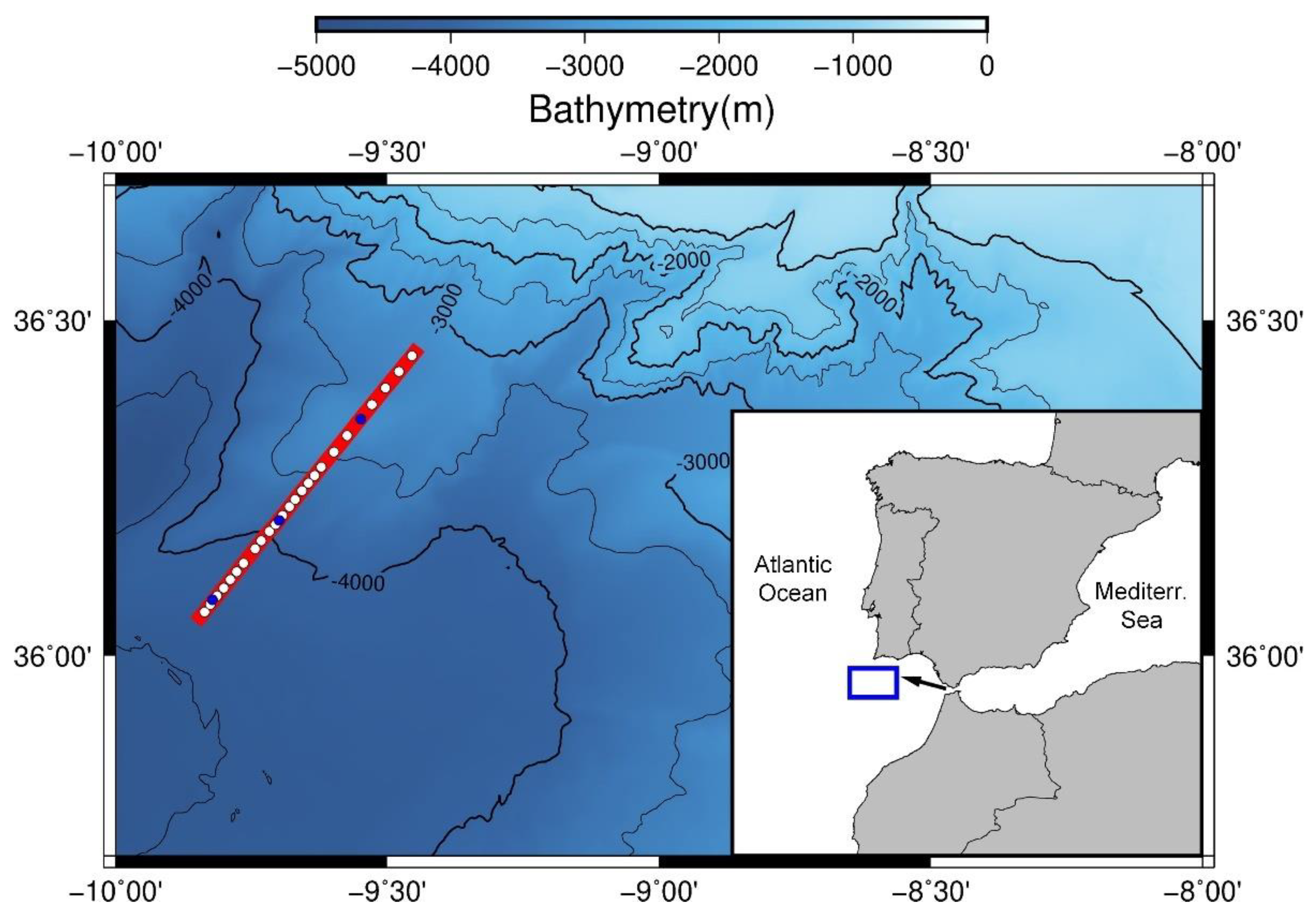
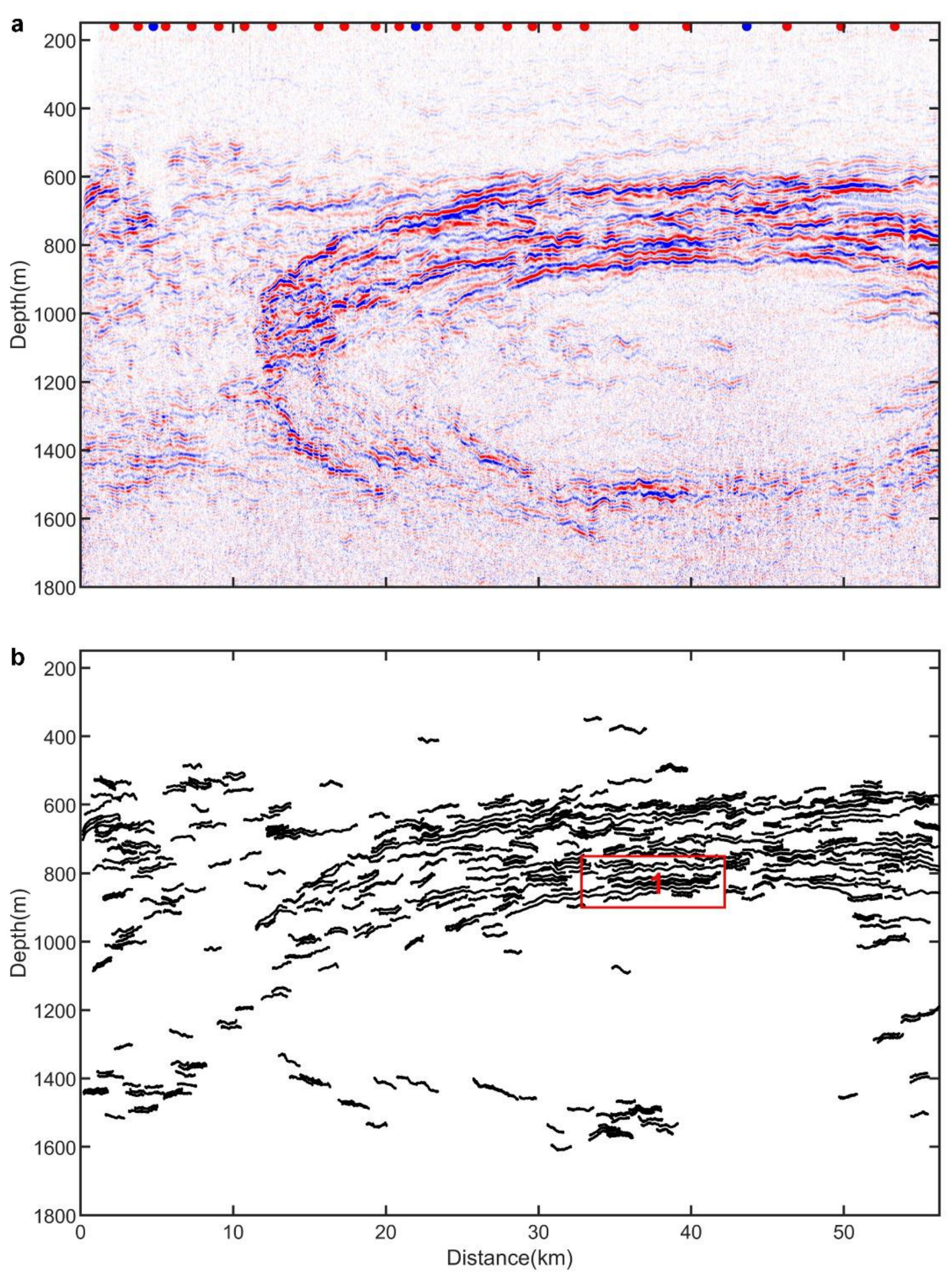
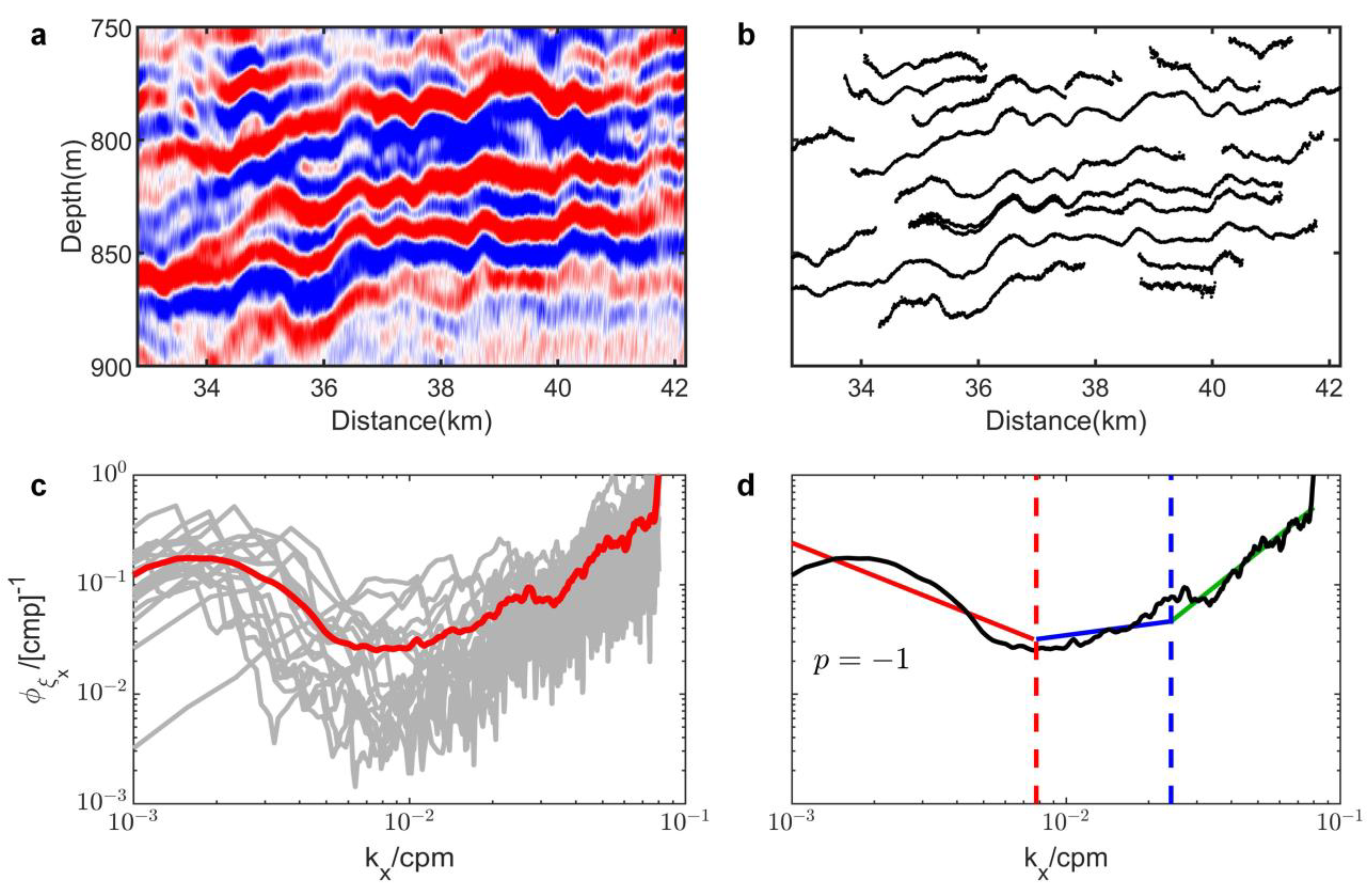
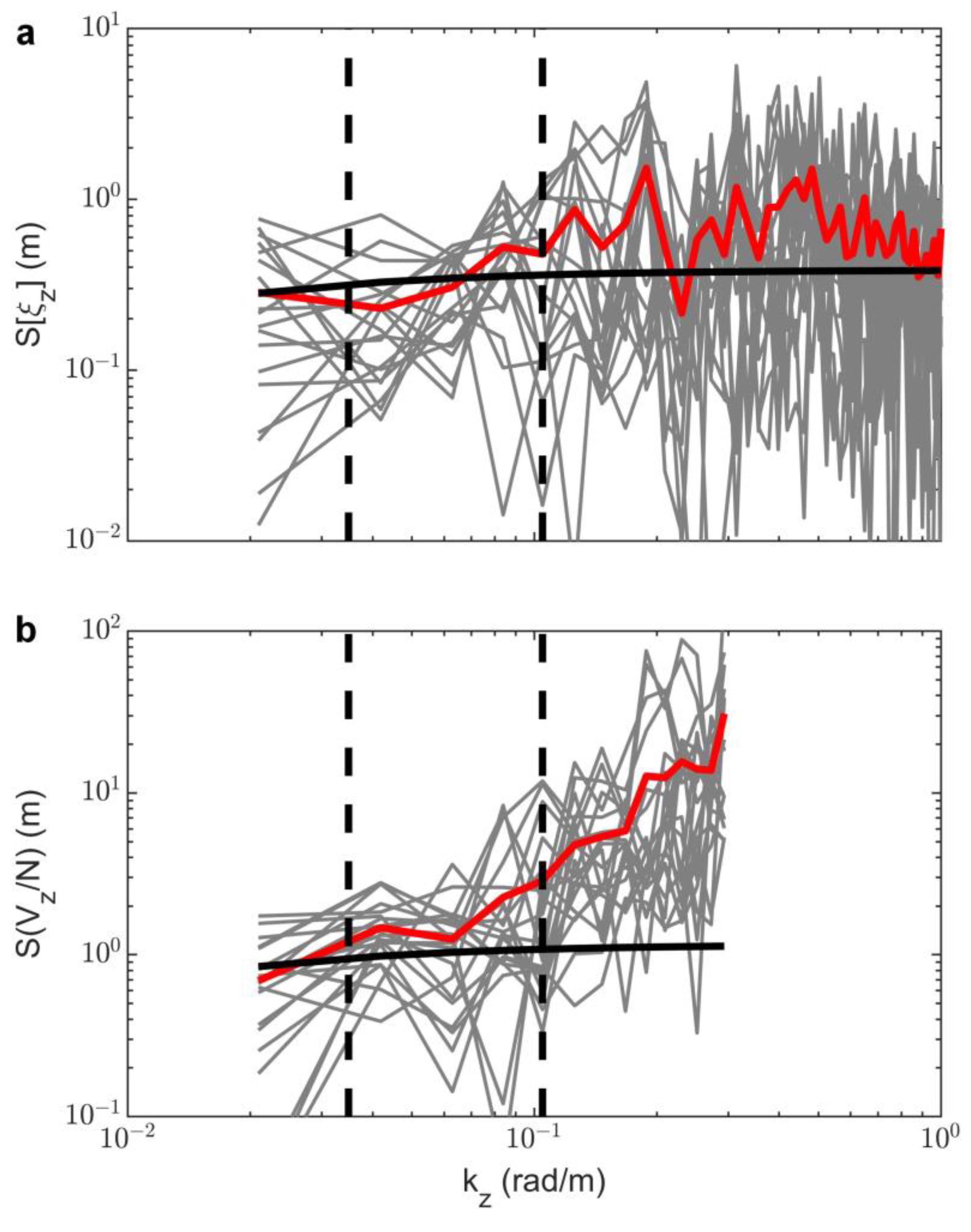
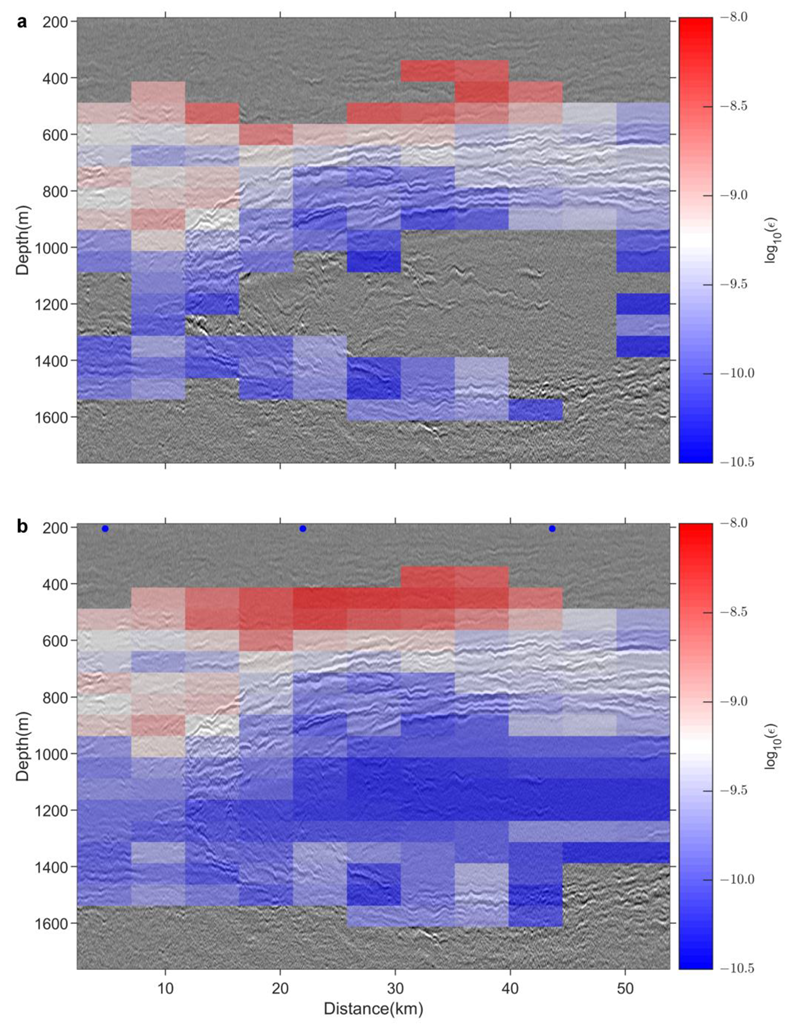
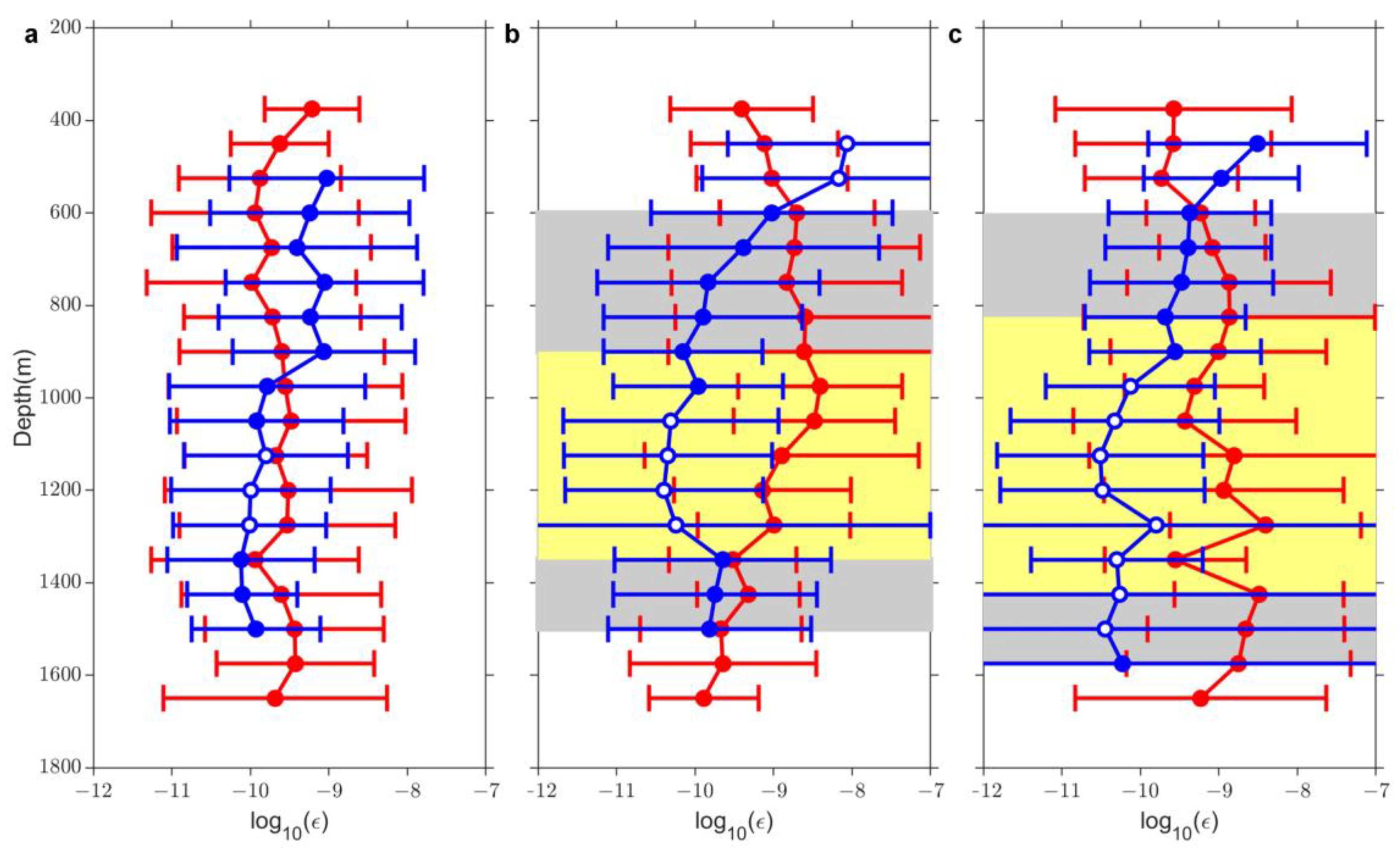
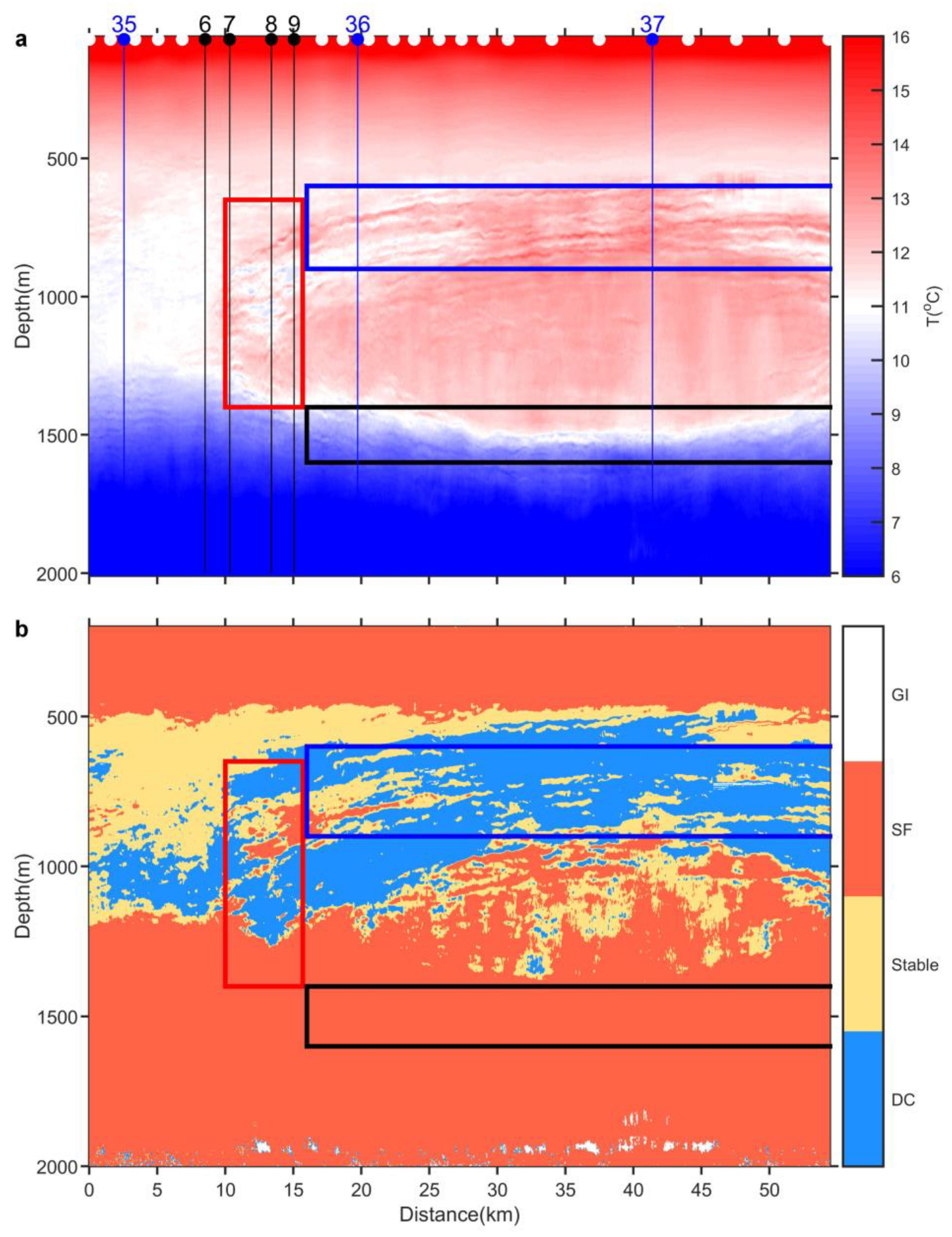
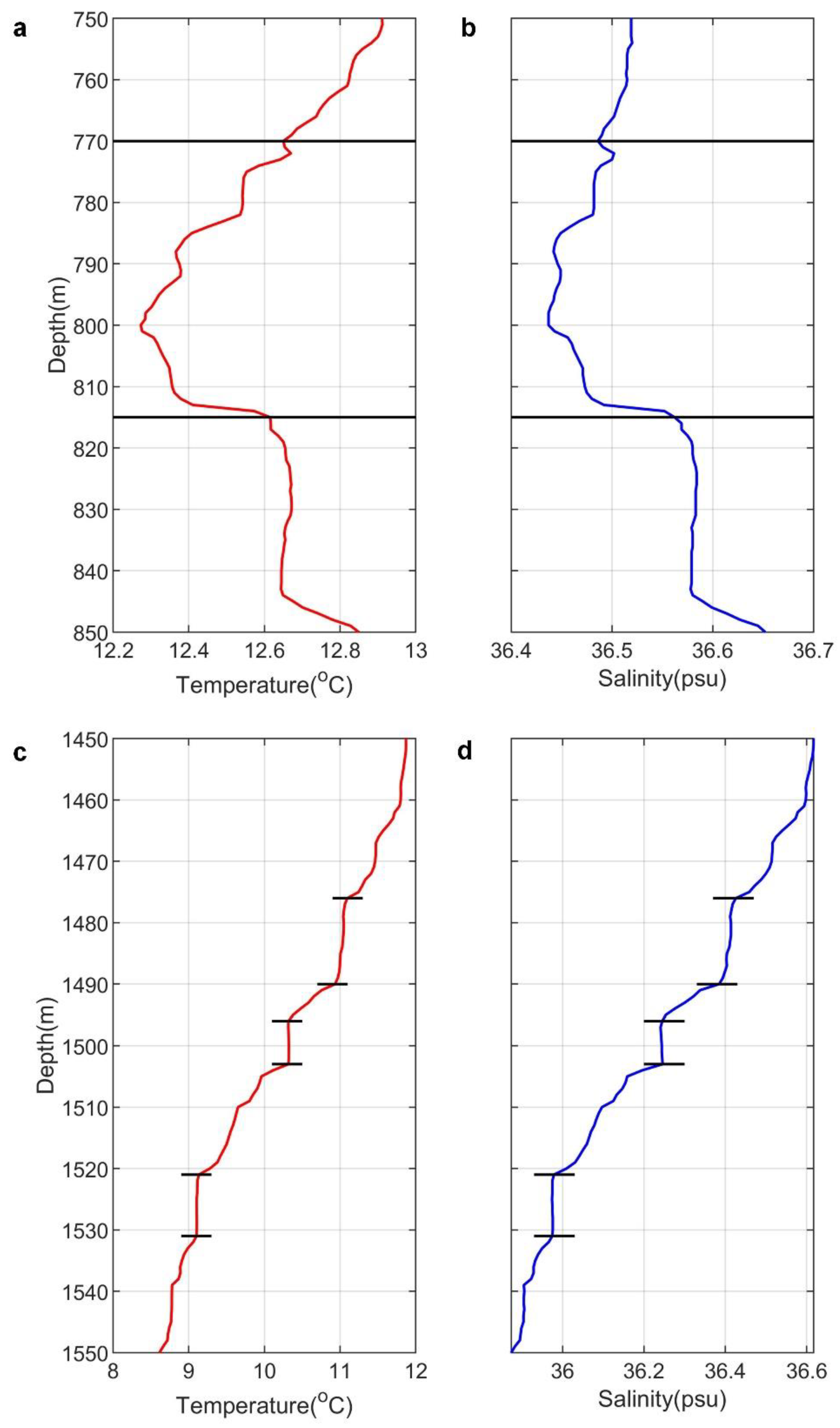
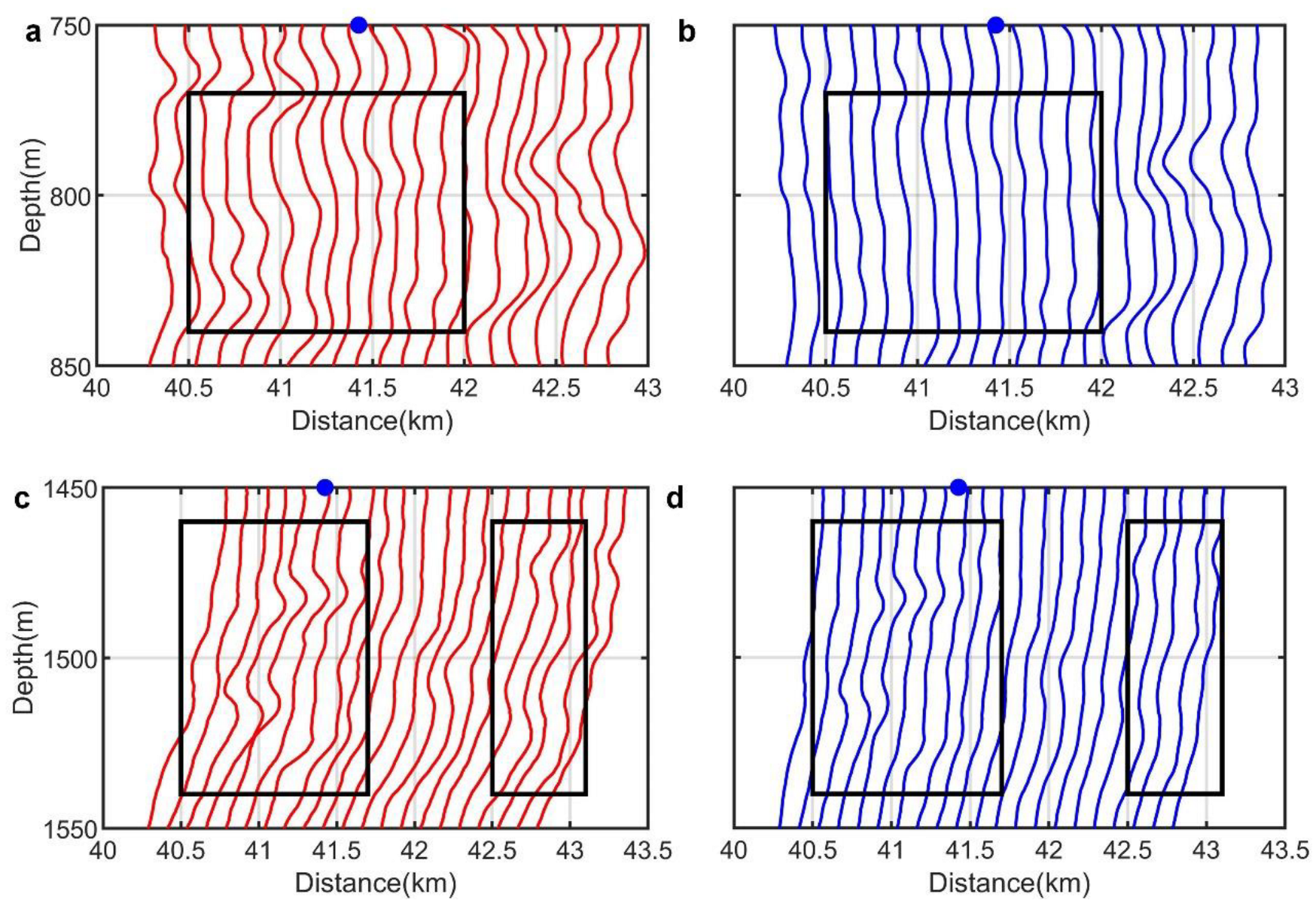
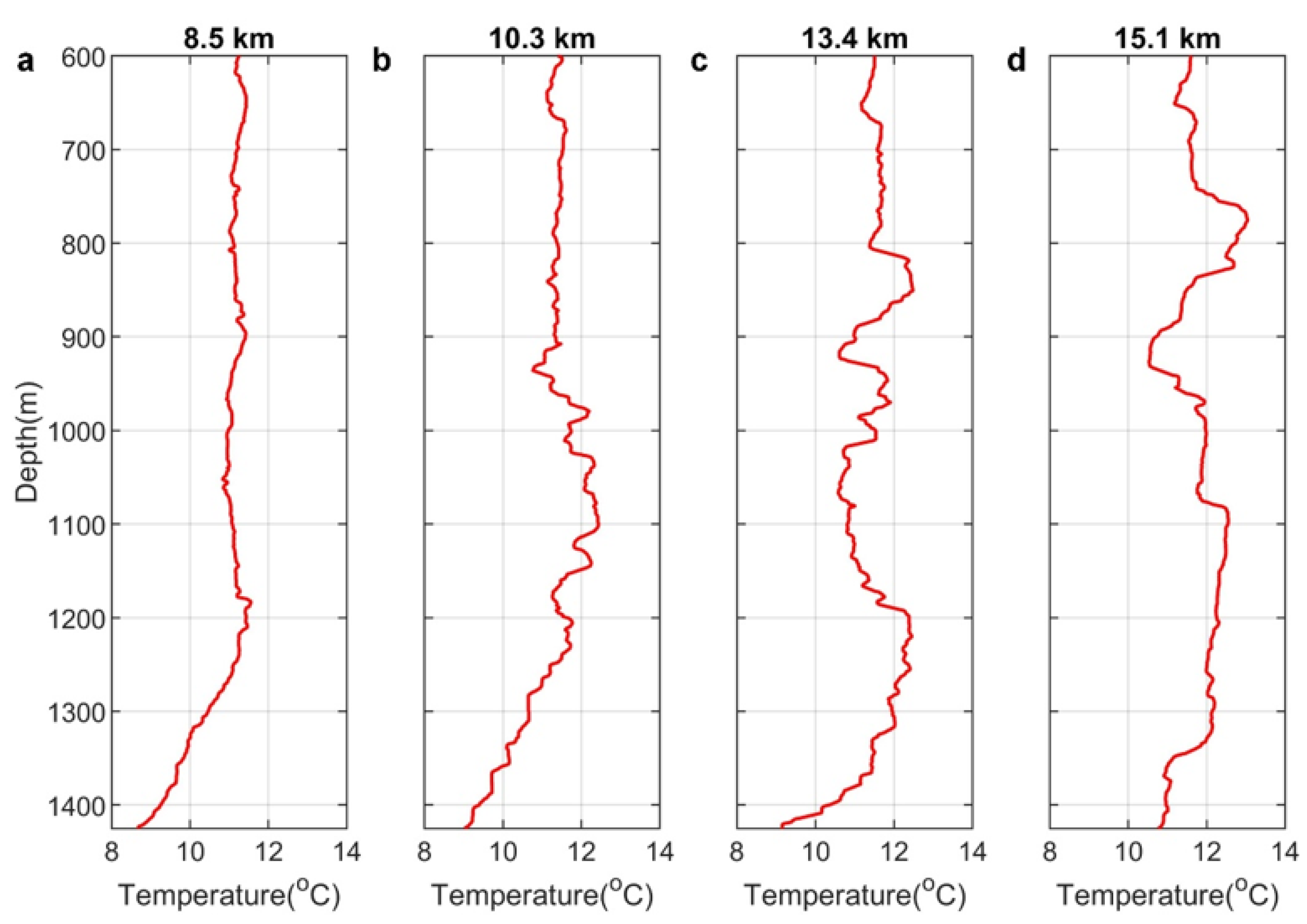

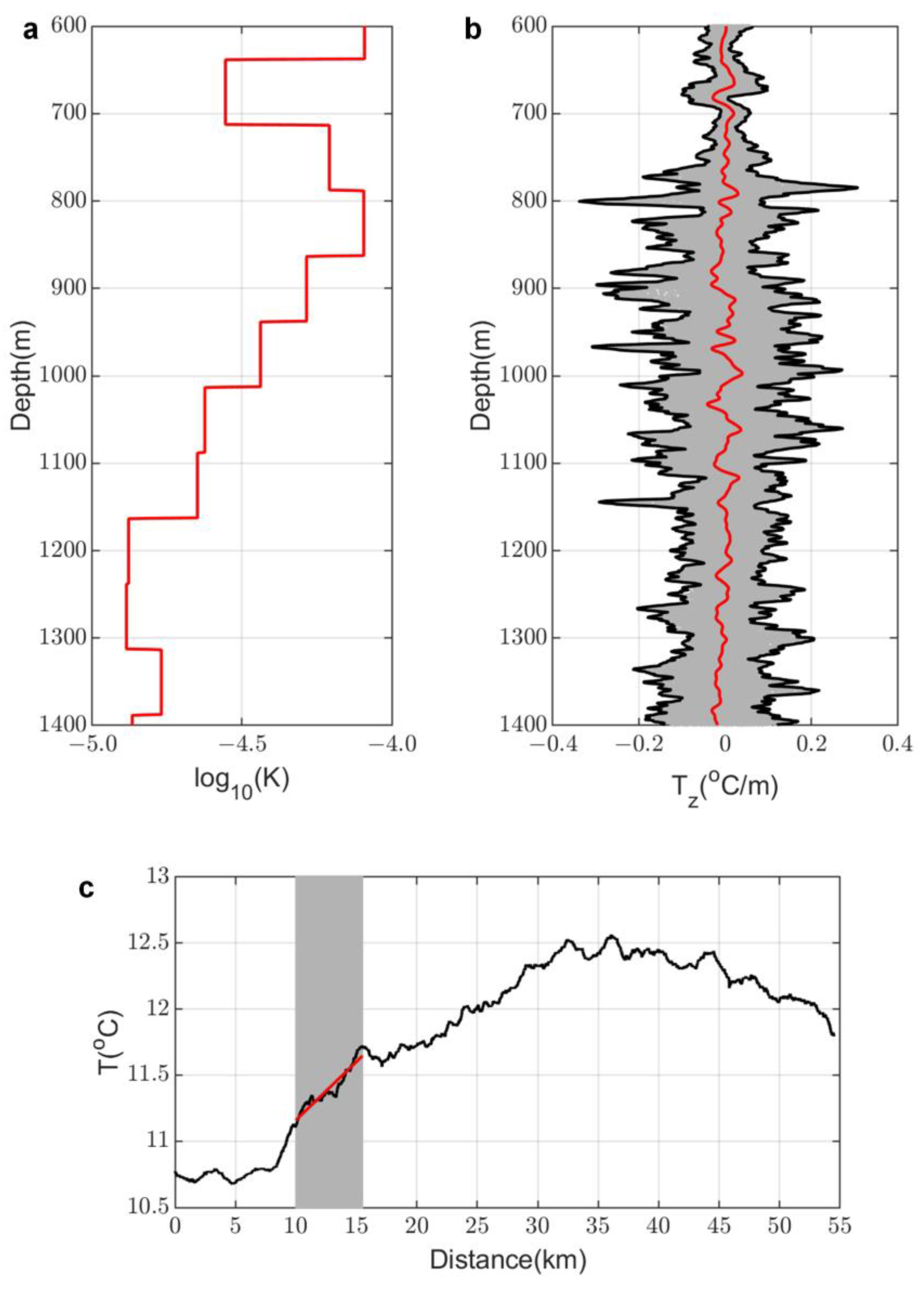
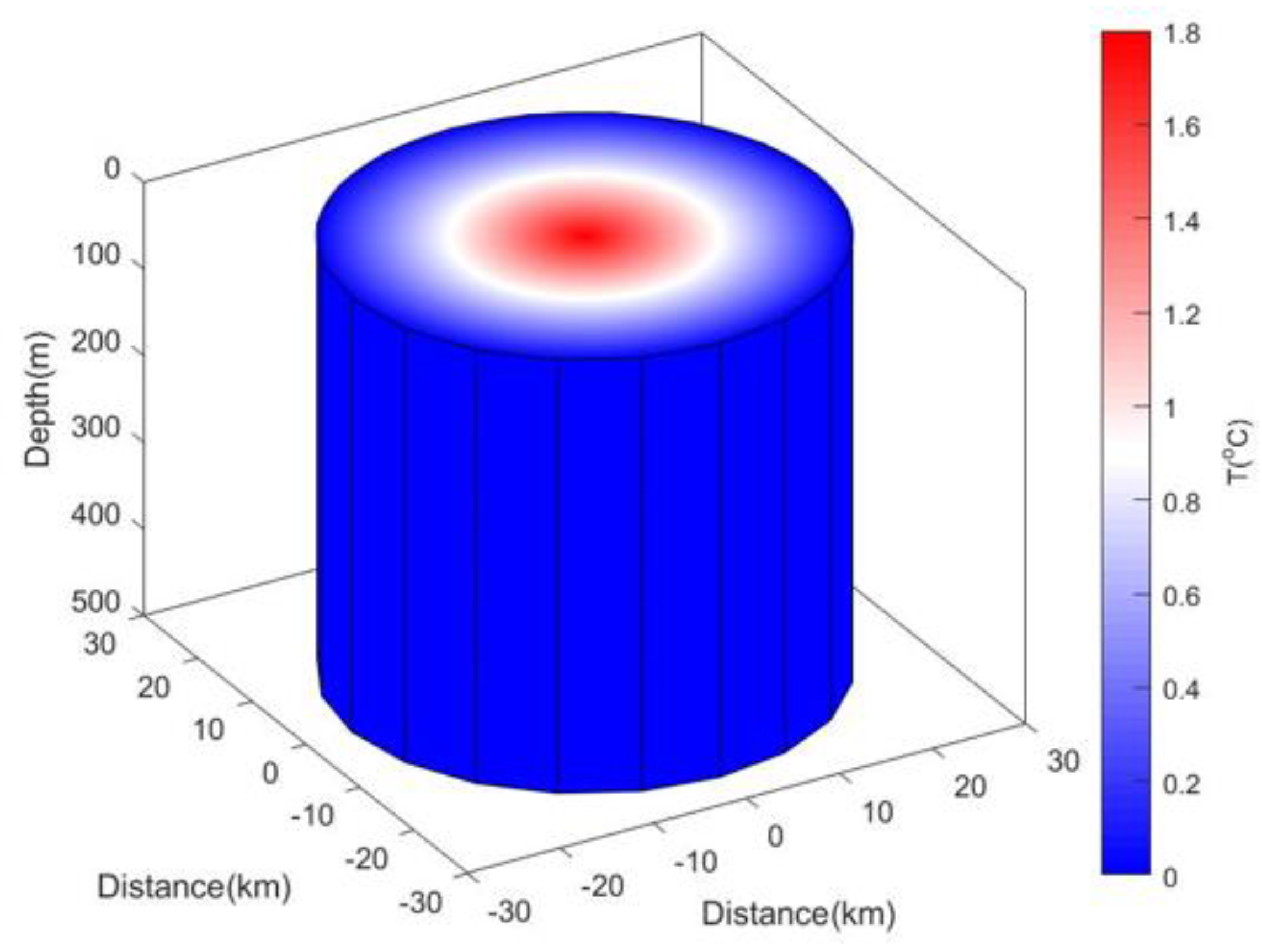
| Frontal Range (km) | 10.0 to 15.5 (5.5) | 12.0 to 14.0 (2) | 11.0 to 15.0 (4) |
|---|---|---|---|
| 8.8 | 6.5 | 8.2 |
| dz = 0.5 m | dz = 1 m | dz = 2 m | |
|---|---|---|---|
| 8.8 | 0.97 | 0.96 | 0.95 |
| 8.2 | 1.12 | 1.12 | 1.10 |
| 6.5 | 1.79 | 1.78 | 1.75 |
| Region | Transport (GW) | Lifetime (Year) | ||
|---|---|---|---|---|
| Eddy flanks (lateral intrusions) | 468.82 | 36.82 | 2 | |
| Above the eddy core (diffusive layers) | 0.20 | 0.40 | 186 | |
| Below the eddy core (salt fingering) | 0.89 | 1.75 | 42 |
Publisher’s Note: MDPI stays neutral with regard to jurisdictional claims in published maps and institutional affiliations. |
© 2022 by the authors. Licensee MDPI, Basel, Switzerland. This article is an open access article distributed under the terms and conditions of the Creative Commons Attribution (CC BY) license (https://creativecommons.org/licenses/by/4.0/).
Share and Cite
Xiao, W.; Meng, Z. Turbulent Heat Fluxes in a Mediterranean Eddy Quantified Using Seismic and Hydrographic Observations. J. Mar. Sci. Eng. 2022, 10, 720. https://doi.org/10.3390/jmse10060720
Xiao W, Meng Z. Turbulent Heat Fluxes in a Mediterranean Eddy Quantified Using Seismic and Hydrographic Observations. Journal of Marine Science and Engineering. 2022; 10(6):720. https://doi.org/10.3390/jmse10060720
Chicago/Turabian StyleXiao, Wuxin, and Zhou Meng. 2022. "Turbulent Heat Fluxes in a Mediterranean Eddy Quantified Using Seismic and Hydrographic Observations" Journal of Marine Science and Engineering 10, no. 6: 720. https://doi.org/10.3390/jmse10060720
APA StyleXiao, W., & Meng, Z. (2022). Turbulent Heat Fluxes in a Mediterranean Eddy Quantified Using Seismic and Hydrographic Observations. Journal of Marine Science and Engineering, 10(6), 720. https://doi.org/10.3390/jmse10060720




